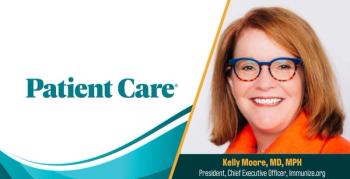
Man With Elevated Platelet Count
A 51-year-old man who has been hospitalized for 7 days for acute pancreatitis has a predischarge platelet count of 812,000/µL.
A 51-year-old man who has been hospitalized for 7 days for acute pancreatitis has a predischarge platelet count of 812,000/L.HISTORY
The patient has chronic alcoholism; he consumes at least one 6-pack of beer per day. He had been on a drinking binge in the weeks before his admission, and for the last week or two of this binge, alcohol had been his main caloric intake. He has had several prior admissions for various alcohol-related disorders, such as alcoholic hepatitis, GI bleeding, and delirium tremens. He has no other major medical problems. A daily multivitamin supplement was recommended, but he fails to take it regularly. He uses proton pump inhibitors intermittently.HOSPITAL COURSE
On admission, the patient's serum lipase level was 1110 U/L. His initial white blood cell count was 11,000/L; platelet count, 104,000/L (normal, 150,000 to 400,000/L); hemoglobin level, 10.2 g/dL; and mean corpuscular volume (MCV), 78 fL. His serum ferritin level was 18 ng/mL (normal, more than 25 ng/mL).A pancreatic ultrasound scan revealed no evidence of gallstones, but it confirmed edematous pancreatitis without pseudocyst. Results of a stool guaiac test were positive for occult blood. Endoscopy revealed acute gastritis without ulcer and without esophageal or gastric varices. A biopsy showed no evidence of tumor or of Helicobacter pylori infection.He responded well to standard conservative measures (no oral intake, intravenous fluids, and analgesia) and gastric acid-reducing therapy. By day 4, he was capable of oral intake.During his hospital stay, the serum lipase level normalized. On day 5, an iron tablet was prescribed. The hemoglobin level dropped slightly after initial hydration, but by day 8, it was 10 g/dL. His platelet count steadily increased to 500,000/L by day 6 and 812,000/L by day 8. A peripheral smear revealed an increased number of platelets but no morphologic abnormalities.Which of the following is the optimal treatment plan for this patient?A. Initiate immediate plateletpheresis to acutely lower the platelet count to less than 600,000/L.
B. Initiate oral anagrelide and titrate dosage to lower the platelet count to less than 600,000/L over the course of 4 weeks.
C. Administer low-dose aspirin therapy if the platelet count reaches--and remains above--106/L.
D. Continue vitamin and iron therapy, and reexamine the patient in 4 to 6 weeks.CORRECT ANSWER: DThe discovery of an elevated platelet count is more common than it was in the past because of the ease of use, accuracy, and widespread availability of Coulter technology for performing blood counts. When thrombocytosis is detected, several key questions must be answered:
- Is the elevated platelet count "reactive" or secondary (a result of normal marrow precursors responding appropriately to elevated levels of thrombopoietin or other marrow cytokines, such as interleukin-6)--or is it a manifestation of intrinsic marrow stem cell disease of a clonal nature?
- If the elevated platelet count is reactive, what are the triggering conditions and are they reversible and/or serious? If the elevated count is of clonal origin, which myeloproliferative disorder is present?
- Is antiplatelet or platelet-lowering therapy required?
In all general series, thrombocytosis is most commonly secondary or reactive.
1
Well-documented causes include acute and chronic blood loss (with iron deficiency); sustained chronic inflammatory or infectious states, such as rheumatoid arthritis or tuberculosis; acute infections and inflammatory conditions; status post-splenectomy; and recovery from thrombocytopenia that has resulted from chemotherapy or otherwise suppressed marrow.This patient has several of these known associated conditions. He presented with a low platelet count, which likely represented the moderate thrombocytopenia caused by the direct suppression by alcohol of megakaryocytes. This phenomenon is seen in about 15% of binge drinkers.
2
He also had a possible folate deficiency related to his poor dietary intake. His acute pancreatitis and some degree of acute GI blood loss were 2 more inciting causes. Finally, he had chronic blood loss with iron deficiency. All these conditions set him up for a profound reactive thrombocytosis once the direct toxic effect of alcohol was removed, folate was replenished, and sufficient time (5 to 15 days) had passed to allow his marrow to recover.
2
The diagnosis of reactive thrombocytosis remains a clinical one. Flow cytometry techniques that involve circulating platelets show promise for distinguishing between reactive and myeloproliferative, clonal platelets,
3
but these are not yet routinely used. Smear abnormalities (eg, giant platelets and megakaryocyte fragments) are helpful clues to clonal thrombocytosis, as is the presence of splenomegaly. This patient has none of these stigmata.Reactive thrombocytosis is a benign disorder that is not associated with either a tendency toward abnormal bleeding or thrombosis. Patients require
no
therapy to either lower their platelet count or alter platelet function. Therapy directed at the inciting cause(s) (eg, treatment of infection/inflammation, replenishment of iron and vitamins as needed, removal of offending drugs or agents [such as alcohol])--and the passage of time--will resolve the abnormal platelet count. Thus, choice D is correct here.Anagrelide (choice B) is an orally administered quinazoline derivative that inhibits megakaryocyte proliferation and differentiation and thereby lowers the platelet count in most patients with myeloproliferative thrombocytosis (eg, essential thrombocytosis, polycythemia vera).
4
This agent has become the first-line therapy in these disorders and would be the initial platelet-lowering agent of choice if the diagnosis were clonal thrombocytosis.Plateletpheresis (choice A) is an aggressive platelet-lowering therapy that is used in the clonal thrombocytoses when the platelet count is extremely elevated (eg, more than 2 × 10
6
/L) or when organ complications from thrombocytosis, such as cerebrovascular symptoms or digital gangrene, are present. Pheresis can temporarily and acutely lower platelet counts, but this therapy should be accompanied by a more permanent cytoreductive maneuver, such as administration of anagrelide or hydroxyurea.Aspirin, choice C--once thought to be contraindicated in myeloproliferative thrombocytosis because high doses caused significant hemorrhagic diathesis--has recently been shown to be an effective adjunctive therapy in patients with clonal thrombocythemias and thrombotic complications when used at low doses.
5
Because this man's thrombocytosis is reactive and not clonal, none of the 3 therapies just described is appropriate.
Outcome of this case.
Iron and vitamin supplements were prescribed at discharge. His family reports that he has abstained from alcohol for 6 weeks. At this time, his hemoglobin level is 12.5 g/dL; MCV, 86 fL; and platelet count, 399,000/L.
References:
REFERENCES:1. Schafer AI. Thrombocytosis. N Engl J Med.2004;350:1211-1219.
2. Ballard HS. The hematological complications of alcoholism. Alcohol Health and Research. 1997;21:41-53.
3. Liu E, Jelinek J, Pastore YD, et al. Discrimination of polycythemias and thrombocytoses by novel, simple, accurate clonality assays and comparison with PRV-1 expression and BFU-E response to erythropoietin. Blood. 2003;101:3294-3301.
4. Tomer A. Effects of anagrelide on in vivo megakaryocyte proliferation and maturation in essential thrombocythemia. Blood. 2002;99:1602-1609.
5. Landolfi R, Marchioli R, Kutti J, et al. Efficacy and safety of low-dose aspirin in polycythemia vera. N Engl J Med. 2004;350:114-124.
Newsletter
Enhance your clinical practice with the Patient Care newsletter, offering the latest evidence-based guidelines, diagnostic insights, and treatment strategies for primary care physicians.

























































































































































































































































































